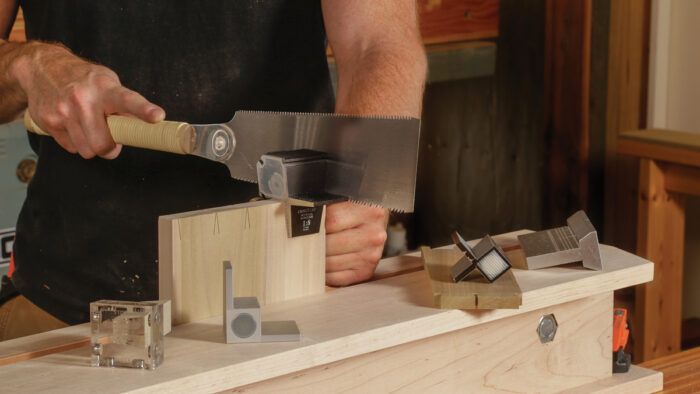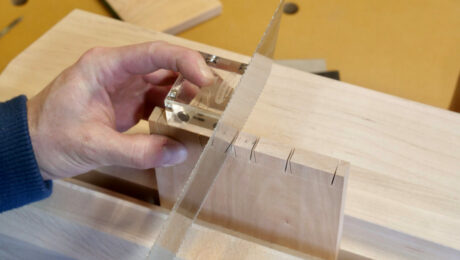Dovetail Saw Guides
Saw guides offer a helping hand whether you're a first-time dovetailer or a pro.

Synopsis: Dovetail saw guides keep your handsaw at a fixed angle for cutting the tails and pins, while simultaneously holding it square to the face and end. Whether you are a first-time dovetailer or an experienced woodworker who doesn’t cut dovetails often, these little tools come in very handy, allowing for clean joints with little fuss. We look at a number of brands on the market, comparing their features so you can make an informed choice.
Dovetail sawing guides may be single-task devices that people have worked without for centuries, but I wouldn’t want to run my professional furniture shop without one. The idea behind them is simple: They hold your handsaw at a fixed angle—the slope of the dovetail—for both the tails and pins. They also hold the saw square for each cut—square to the face for the tails, and square to the end for the pins. As a result, they take much of the stress out of dovetailing. Far from being a solution without a problem, these guides can benefit everyone except the absolute dovetail expert in several ways.
First and probably foremost is confidence. As with anything, believing you can do something is critical to success. When a novice dovetailer cuts a corner joint, taps it together, and it seats nicely without gaps, they’re hooked. I know that was the case for me. After stumbling through a few joints without a guide, I had started to think adding dovetails to my work wasn’t going to happen.
Then I decided to try a guide. Right out of the gate, first try, I had a very nice joint. I needed that win to give me the confidence to try dovetailing on an actual project.
Confidence is also critical for the seasoned woodworker who has cut lots of dovetails—again, like me. For example, if I am dovetailing a case, I have already invested several hours into panel glue-ups where I’ve used specially selected, beautiful boards. And this case may already have some joinery, like dadoes, and shelf-pin holes. In other words, the stakes are high. A mistake on one of the workpieces would mean a lot of work to repair or remake the part, and that’s enough to spook me a bit. A dovetail guide helps me execute each of the four corner joints accurately, precisely, and without mistakes.
Avoiding mistakes points to another benefit: consistency. I am certainly no Christian Becksvoort, but I am pretty good at cutting dovetails without a guide. Still, every so often I simply make a mistake, like not sawing square to the face on a tail. I honestly have never made this mistake while using a guide.
Plus, the guide means I’m always consistent; I don’t need to worry if I’ve gotten rusty. I am a cabinet and millwork kind of builder, so I use screws, biscuits, and glue for most of my joinery. But a few times a year, a customer will approach me looking for finer work, and I’ll use as many dovetails as I can. Because this happens infrequently, I may not have had the chance to cut a dovetail for months. Using a sawing guide allows me to jump right in and cut clean joints without much fuss. Without the guide, I would need to do a few practice joints—spending time and effort away from a paying gig—to even get close to an acceptable joint.
This brings me to the third benefit, speed. For all but the most seasoned professional, using a guide will speed up the process; and let’s face it, cutting dovetails takes lots of time. Not only the act of sawing, but the whole process from start to finish. If you saw accurately, there’s no checking and paring before transferring the joint. Each step builds on the last, and these little improvements mean a corner that is finished faster. I don’t want to toot my own horn, but directly off the saw using a guide, I can cut a dovetail joint that is as close to perfect as possible. You can, too, once you get familiar with your guide.
To view the entire article, please click the View PDF button below.
More by Mike Farrington
 |
Let’s cut a dovetail joint using a sawing guide |
 |
Dialing in a dado stack on the first try |
 |
A couple neat things to keep around the shop |
Fine Woodworking Recommended Products

Bessey EKH Trigger Clamps

Stanley Powerlock 16-ft. tape measure

Jorgensen 6 inch Bar Clamp Set, 4 Pack






 From
From 





Log in or create an account to post a comment.
Sign up Log in